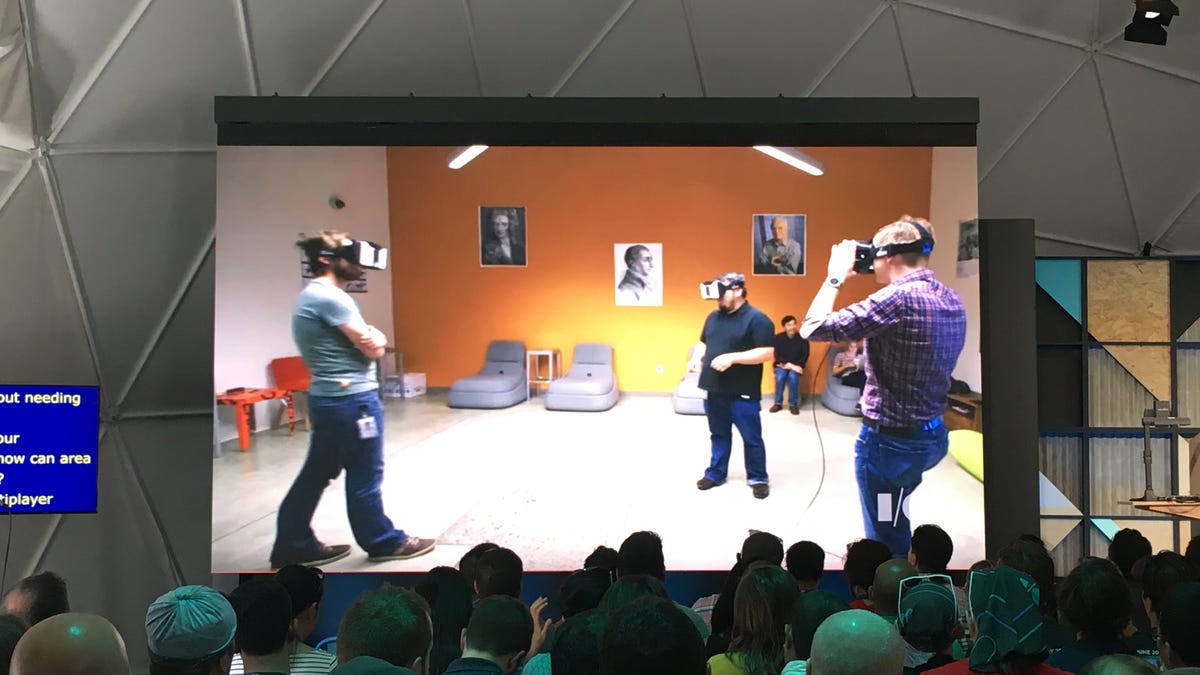Google VR: How it should (and could) evolve beyond Daydream
Google's upcoming Daydream mobile VR platform isn't the final step at all. Project Tango, among other things, is part of the next wave.

Google's got a new vision of virtual reality, and it's not coming until the fall. Daydream is mobile, works across multiple Android phones, and will dig deep into the upcoming Android N OS. But if you think this is the end point for Google and VR, think again.
Quite a few things have been left off the plate for Daydream, things that several people -- myself included -- expected at this year's Google I/O developer conference. I think two of my four expectations were met. But just because they're not here now doesn't mean they're not on the way. VR is a moving target, and this is where it'll likely move next.
Wandering through 3D space on a phone: Meet Project Tango
There's another shoe that's yet to drop for Google and VR, and it's a big one called Project Tango. "Inside-out tracking" has become the catchphrase for using cameras and sensors to track the world around you. Headsets like Microsoft's HoloLens and the Meta 2 use this type of tracking to find where objects are in a room and place 3D virtual objects in your field of view. Google's own Project Tango has enabled similar things for years. Google has already cracked the code for how to track movement in 3D space, but it stands apart from VR for now.
Tango uses advanced 3D depth-sensing cameras to map out an area, and even learn about spaces. It can track movement and place objects over reality. But Tango exists only on developer-edition tablets. Soon it'll be added to an upcoming consumer-targeted Lenovo Tango smartphone.
Tango hasn't emerged in mobile VR yet, although it will. (It's under the purview of the same VR team.) As Google VP of Virtual Reality Clay Bavor has said, Daydream and Project Tango share the same offices, "and I'll let you extrapolate from there."
Google's Jump cameras are getting new partners, including Imax.
Making amazing virtual worlds takes better cameras
Making more impressive video content, 360 and 3D videos, is part of what defines good VR. Google's making inroads with Jump, which knits multiple cameras into a 3D 360-degree array. The GoPro Odyssey, which has 16 GoPro cameras, is already in use.
Google has other, more advanced cameras in the works. A version using 4K cameras from Yi, plus a professional cinema-grade Imax version, are in development. YouTube will be fully operational as a VR content delivery app in Daydream, too. The more high-quality videos that exist, the better and deeper the VR library.
It also takes better controllers
Google has its own design lab to explore the future of VR, called Daydream Labs. And from the videos we've seen so far, it looks like that team largely uses the HTC Vive. Developer sessions show people playing with the Vive in all sorts of ways, like the keyboard drum demo above.
The reason they've chosen to use a Vive seems clear: it's the most advanced VR hardware available. It shows the best-case scenario, and allows people to imagine concepts that mobile VR can't achieve yet. And unlike mobile VR systems, the Vive has full room tracking and uses two wireless controllers. Google's upcoming Daydream just uses one, and it's more simply designed.
The Daydream VR controller coming in the fall only needs one hand.
The Daydream single controller, which feels like an Apple TV remote-meets-Wii remote, has accelerometer motion controls, a trackpad and a few buttons. It looks like it will handle basic needs and be a better option that most other mobile Bluetooth game controllers. But I'd argue it's still not the perfect answer.
If you want to guess where Google wants to go next in mobile VR, look at Tiltbrush. It's one of the best experiences you can have on the PC-connected HTC Vive. And, by the way, Google acquired Tiltbrush last year.
Tiltbrush uses advanced dual motion controllers to paint in 3D space. Could Daydream end up with its own Tiltbrush someday? I asked Bavor whether Daydream could support two controllers, and he suggested it wasn't part of the current design. That doesn't mean it couldn't happen.
Beyond controllers, there could even be the promise of full hand tracking. But the one thing Project Tango won't do is enable hand tracking -- yet. According to Project Tango's lead developer Johnny Lee at Google I/O, "the depth sensor in Project Tango is really more optimized for room scanning."
In two years, everything will be different
To make programs like Tiltbrush, you also need to move through 3D space. Positional tracking like that can only happen on higher-end nonmobile systems like Oculus Rift, HTC Vive and PlayStation VR. For now. Add built-in positional tracking cameras like Project Tango, and mobile VR might be nearly there.
In fact, if you want to know the future of mobile VR, just use desktop PC-based VR. Use an HTC Vive. Try the motion controllers. Explore the holodeck. That's what mobile VR hopes to achieve.
"In two years, this will look a lot different, right?" Google's Bavor said of Google's VR platform, Daydream, during a conversation with CNET. "And of course we're thinking about positional tracking. Of course we're working on positional tracking." Positional tracking means moving through 3D space, walking around on the holodeck. This is exactly what Project Tango can enable. Google's most polished Tango demos have demonstrated navigating through worlds, both real and virtual, at the same time. It can handle the load.
This mirrors what Oculus has said about mobile VR. It's what the industry is inevitably moving toward. Google Daydream is one step. But the important thing to remember is that the other step may not be all too far behind.
But not yet. When? Clay Bavor probably knows.

